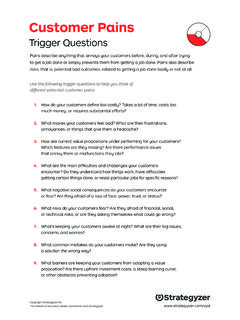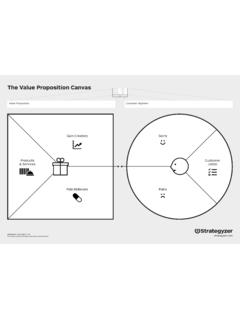Transcription of Preventing manual handling injuries to catering staff
1 Page 1 of 6 Health and Safety ExecutiveHSE information sheetCatering Information Sheet No 24 IntroductionThis information sheet was produced by the Hospitality and catering Industry Liaison Forum, which has members from trade and professional associations, unions and enforcement authorities. Members associations are free to reproduce and distribute this guidance to catering establishments. The guidance is issued by the Health and Safety guidance is aimed at employers of catering staff , but provides useful information for employees and safety representatives. It identifies significant risk areas and offers practical examples of solutions you can apply in your workplace.
2 Further HSE guidance on manual handling and Preventing back pain and other upper limb injuries is available on HSE s website. There are also links to tools that will help you assess the risk involved in lifting and repetitive tasks. manual handling causes over a third of all workplace injuries . These include work-related musculoskeletal disorders (MSDs) such as pain and injuries to arms, legs and joints and repetitive strain injuries of various sorts. manual handling covers a wide variety of activities including lifting, lowering, pushing, pulling and carrying. If any of these tasks are not carried out appropriately there is a risk of handling injuries can have serious implications for both the employer and the person who has been injured.
3 They can occur almost anywhere in the workplace and heavy manual labour, awkward postures and previous or existing injury can increase the risk. To help prevent manual handling injuries in the workplace, you should avoid such tasks as far as possible. However, where it is not possible to avoid handling a load, employers must look at the risks of that task and put sensible control measures in place to prevent and avoid injury, using lifting aids where necessary. What the law saysThe manual handling Operations Regulations 1992 require you to avoid any manual handling operations at work which involve a risk to health so far as reasonably it is not reasonably practicable to avoid any manual handling operations, you must carry out a manual handling risk assessment to identify how the risk is caused, so each factor can be addressed and measures taken to control the of information, instruction and training to staff are legal for employersKey messages You can easily take action to prevent or minimise this type of injury.
4 The preventive measures are cost-effective. Involving staff is key to success. Training staff to use proper lifting techniques and handling aids and raising awareness of the risks will reduce the likelihood of injuries in future. Early detection and reporting of aches and pains is messages for employees Employees need to take care to protect their own health and safety and that of colleagues by using equipment properly, wearing protective clothing and following safe working practices. Cooperate with the employer in complying with their legal duties by following instructions and reporting health and safety issues, such as faulty equipment or worn personal protective equipment (PPE).
5 Preventing manual handling injuries to catering staffHealth and Safety Executive Page 2 of 6 Where to start (risk assessment)You should start by considering the jobs carried out in the kitchen and the staff who work there. Look at the areas of work where there are most likely to be significant risks and prolonged exposure examples of common risks and suggestions on how to reduce them are provided throughout this information information can form the basis of your risk assessment and you should concentrate on: the handling tasks workers are doing; the loads they are lifting; the environment they are working in; the individual capabilities of each worker; the positions they need to get in to do the job, eg twisting and stretching.
6 The time spent on each task, eg regularity of lifting and break your staff , their representatives and safety representatives in the process, as they will be able to tell you how tasks are actually done and highlight any problem areas and possible solutions. They may also have identified hazards or risks you are not aware of you have more than five employees, record the findings of your risk assessment. You can find examples of risk assessments on the HSE website. If you have fewer than five employees, you don t have to write anything down but it is good practice to keep a record. Keeping a record will act as a future reminder of what you did and why, and will make future reviews easier and has produced an assessment guide known as the MAC tool ( manual handling assessment chart) to help you identify tasks with significant risks in lifting, carrying and team handling operations: The ART tool (assessing repetitive tasks) has the same function for tasks that could lead to upper limb disorders.
7 Note that the MAC and ART tools are not appropriate for all manual handling jobs, eg those that involve pushing and pulling. Avoid the risk Your first priority should always be to avoid the risks entirely, if reasonably practicable. Examples of ways to avoid risks include: reorganising the layout of the kitchen to avoid unnecessary stretching and/or lifting; using a dishwashing machine; having breaks or using job rotation to minimise the time each individual spends on jobs where there may be a risk. If the risk cannot be avoided You can improve workplace conditions. For example: replace or repair uneven or slippery floors; keep floors dry and free from contamination by cleaning up spills immediately (see CAIS6 Preventing slips and trips in kitchens and food service; provide trolley ramps at changes in floor level; keep all catering equipment well-maintained; ensure shelving is not overloaded; install automatic doors if staff have to carry things through them can use mechanical aids to make it easier, including: four-wheeled trolleys (with adjustable height or lockable castors, if needed); large mixer bowls on wheeled dollies; sack trucks.)
8 False bottoms in deep sinks to reduce awkward bending at the redesigning individual tasks to: reduce the amount of twisting, bending, stooping, stretching, pushing and pulling; reduce the number of times it is necessary to do the task (but without increasing the load each time); store heavy items on shelves at waist height; use team-working for tasks such as moving a heavy pot. Consider making loads easier to handle. For example: buy cooking oil in easier-to-handle cardboard boxes with sturdy handles/grips; break down trays of A10-size cans before loading onto storage shelving; use smaller containers for cleaning chemicals and/or appropriate siphons or pumps to avoid handling bulk containers; Health and Safety Executive Page 3 of 6 put heavy equipment such as chest freezers on (lockable) castors to make cleaning routines easier.
9 You must provide appropriate tools, equipment and protective clothing, based on your risk assessment. DishwashingThe risks associated with dishwashing are: repeated lifting and handling of full dish racks or heavy dish trays and cutlery buckets; repetitive twisting and bending at sinks or leaning over sinks; awkward reaching across sinks or work surfaces when manually cleaning dishes; grasping dishes by fingertips (pinch grips).Consider providing: dishwashers; rollers or conveyors; trolleys to move large quantities of dishes; cleaning tools with good grips when heavy-duty cleaning is required; appropriate gloves and non-slip shoes where required gloves should fit properly and, if required, have extra grip on palms and fingertips to reduce the gripping force needed to handle greasy dishes; foot rails or a step to shift body weight and reduce stress on employees lower back and legs when standing for long periods.
10 Train staff to: push trays along counters towards the dishwasher rather than lifting; not overload dish racks and, if they have to lift them, to use more than one rack to spread the load; grip trays at the midpoint when carrying them rather than the front edge, keeping the tray as close to the body as possible, but bearing in mind any risks of contact with hot washing Most pot washing will be done manually in large deep sinks, although some employers may have automatic pot-washing machines. The risks associated with these tasks are: lifting heavy pots; awkward bending and twisting when leaning over sinks for long periods; repetitive wrist and shoulder movements when scrubbing pots; repetitive reaching into pots; forceful arm exertions when scrubbing providing: pot-washing dishwashers if appropriate; false bottoms in deep sinks to reduce awkward bending at the waist; water jet sprays.












